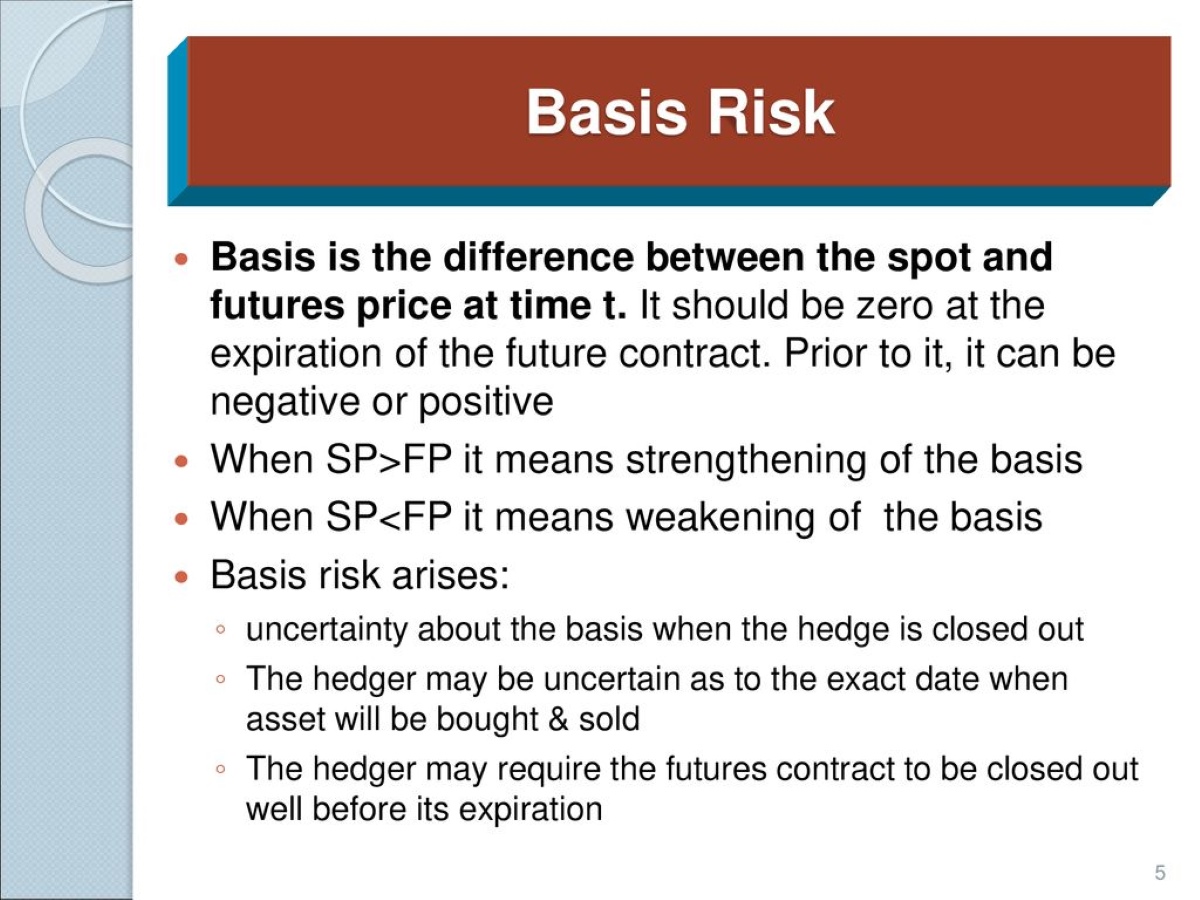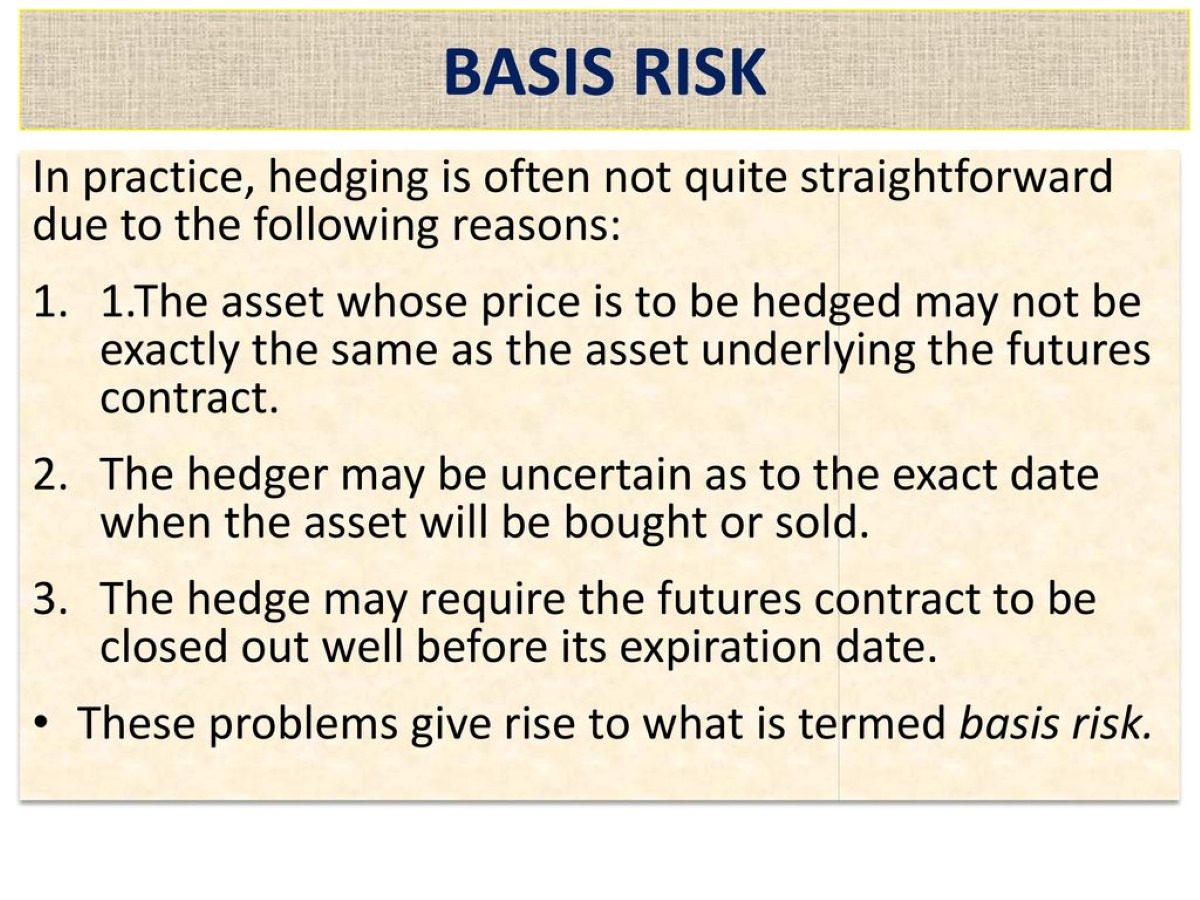Home>Finance>. What Is The Value At Risk Approach To Hedging?


Finance
. What Is The Value At Risk Approach To Hedging?
Published: January 15, 2024
Discover the value at risk approach to hedging in finance and learn how it helps manage risks and protect investments.
(Many of the links in this article redirect to a specific reviewed product. Your purchase of these products through affiliate links helps to generate commission for LiveWell, at no extra cost. Learn more)
Table of Contents
Introduction
When it comes to the world of finance, managing risk is a paramount concern for individuals, companies, and institutions. The unpredictability of the financial markets can pose significant challenges, necessitating the need for effective risk management strategies. One approach that has gained traction in recent years is the Value at Risk (VaR) approach to hedging.
Hedging is a risk management technique used to offset or reduce the potential losses from adverse price movements in financial instruments. It involves taking a position in a related asset or financial derivative to mitigate the exposure to market volatility. While there are various methods of hedging, the VaR approach offers a comprehensive and quantitative analysis of risks.
The Value at Risk (VaR) is a statistical measure used to estimate the maximum potential loss on a financial portfolio over a specific time horizon and at a given confidence level. In simpler terms, it provides an estimate of the worst-case scenario a portfolio could face within a certain probability level. By using this approach, investors can gain a clearer understanding of the potential downside risks associated with their investments.
The VaR approach to hedging focuses on quantifying and managing the risk exposure of an investment or portfolio. It provides a framework for assessing the potential losses under different market conditions, allowing investors to make informed decisions and take appropriate actions to mitigate risk.
In this in-depth article, we will delve into the concept of hedging and the role of risk management in finance. We will then explore the Value at Risk approach, its benefits, limitations, and practical implementation in hedging strategies. Understanding the VaR approach to hedging can provide investors with valuable insights and tools to navigate the complex and volatile financial markets.
Understanding Hedging
Hedging is a risk management technique used by individuals, companies, and institutions to protect against potential losses arising from adverse price movements in financial instruments. It involves taking offsetting positions in related assets or financial derivatives to minimize the impact of market volatility on the overall portfolio. The goal of hedging is not to make profits, but rather to reduce the potential downside risks associated with investments.
The concept of hedging can be traced back to ancient times when farmers used to hedge their crops against price fluctuations by entering into forward contracts with buyers. Today, hedging has evolved to encompass a wide range of financial instruments such as futures contracts, options, and swaps.
There are two primary types of hedging: long and short. A long hedge involves taking a position that will profit if the price of an asset increases. For example, an oil producer may enter into a futures contract to lock in a future selling price, protecting themselves against a decline in oil prices. Similarly, a short hedge involves taking a position that will profit if the price of an asset decreases. An airline, for instance, may enter into a futures contract to lock in a future purchase price for jet fuel, protecting themselves against a rise in fuel prices.
Hedging serves as a valuable tool for managing risk in a variety of scenarios. It allows investors to protect their portfolio from potential losses caused by market downturns. For businesses, hedging can reduce the impact of adverse price movements on their bottom line, thereby ensuring stability and predictability in their financial performance. Additionally, hedging can be beneficial for speculators who seek to profit from price fluctuations or for investors seeking to diversify their portfolios.
It is important to note that while hedging can mitigate risk, it does not eliminate it entirely. There is always the possibility of unforeseen events or market conditions that can result in losses despite hedging efforts. Therefore, careful consideration and analysis are crucial when implementing hedging strategies.
Understanding hedging and its role in risk management is essential for investors and businesses operating in volatile financial markets. By effectively hedging their positions, they can protect themselves from potential losses and ensure a more stable and secure financial future.
The Need for Risk Management
In the world of finance, risk is an inherent and unavoidable aspect of investment. The global financial markets are subject to a myriad of factors that can lead to unexpected losses and volatility. It is crucial for individuals, companies, and institutions to implement effective risk management strategies to safeguard their investments and maintain financial stability.
The need for risk management arises from the following key reasons:
- Preservation of Capital: Risk management aims to protect the capital invested by minimizing potential losses. By identifying and assessing risks, investors can make informed decisions and take appropriate actions to preserve their wealth.
- Stability and Consistency: By managing risks, investors can achieve a more predictable and stable financial performance. This is particularly important for businesses that rely on consistent profits and cash flow to sustain operations and meet obligations.
- Avoiding Financial Catastrophes: Failure to manage risks can result in significant financial disasters. It can lead to bankruptcy, severe losses, and irreparable reputational damage. Risk management provides a framework for identifying and mitigating potential threats to financial well-being.
- Regulatory Compliance: Many industries and financial institutions are required to adhere to regulatory frameworks that mandate risk management. By implementing robust risk management practices, organizations can ensure compliance with laws and regulations, avoiding legal consequences and penalties.
- Enhanced Decision-making: Risk management provides investors with valuable insights into the potential risks and rewards associated with their investments. This allows for more informed decision-making, as investors can weigh the potential benefits against the risks involved.
- Market Volatility and Uncertainty: Financial markets are characterized by volatility and uncertainty. Risk management helps investors navigate these unpredictable conditions by identifying and addressing potential risks in a systematic manner.
Risk management encompasses a range of strategies and techniques that are tailored to individual risk profiles and investment objectives. It involves identifying, assessing, and prioritizing risks, followed by the development and implementation of appropriate risk mitigation strategies.
By proactively managing risks, investors and businesses can protect themselves from potential financial losses, enhance decision-making capabilities, and ensure stability and growth in an ever-changing financial landscape. Risk management is a crucial discipline that contributes to the long-term success and resilience of financial portfolios and businesses.
What is Value At Risk (VaR)?
Value at Risk (VaR) is a widely used statistical measure in finance to estimate the potential loss on a portfolio of investments over a specific time horizon with a given level of confidence. It provides investors with an insight into the maximum amount they can expect to lose under normal market conditions.
VaR is typically expressed as a dollar amount or a percentage of the portfolio’s value. For example, if a portfolio has a one-day 1% VaR of $100,000, it means that there is a 1% chance of losing $100,000 or more within a single trading day.
The calculation of VaR takes into account several factors including the volatility of the portfolio’s assets, the correlation between different assets, and the chosen confidence level. The confidence level represents the probability or level of certainty that the estimated VaR will not be exceeded. Common confidence levels used in practice are 95% and 99%.
There are several methods used to calculate VaR, including historical simulation, parametric VaR, and Monte Carlo simulation. Each method has its own assumptions and limitations, and the choice of method depends on the characteristics of the portfolio and the preferences of the investor.
VaR is a valuable tool in risk management as it provides a quantitative measure of the potential downside risk of a portfolio. By understanding the VaR of their investments, investors can better assess the risks they are exposed to and make informed decisions to mitigate those risks.
Value At Risk Approach to Hedging
The Value at Risk (VaR) approach can be effectively applied in the context of hedging to manage and mitigate risks associated with investment portfolios. By utilizing VaR, investors can assess the potential losses that their portfolio may face under different market conditions, enabling them to implement hedging strategies that counteract these risks.
When applying the VaR approach to hedging, the first step is to calculate the VaR of the portfolio. This involves analyzing the historical data of the portfolio’s assets, considering their volatility and correlation. By considering the portfolio’s risk factors, a quantified estimation of the maximum potential loss can be determined at a given confidence level.
Once the VaR of the portfolio is calculated, investors can identify the specific risks that need to be hedged. For example, if the VaR analysis indicates a significant risk exposure to changes in interest rates, the investor can implement a hedging strategy using interest rate futures or swaps to offset that risk.
By incorporating the VaR approach into the hedging strategy, investors can mitigate the potential losses caused by adverse market movements. Hedging instruments, such as futures contracts or options, can be used to offset the risk exposure identified through the VaR analysis.
For instance, if a portfolio has a VaR of $50,000 at a 99% confidence level over a one-day time horizon, the investor can utilize hedging instruments to limit the potential loss to a specified amount, such as $10,000. This helps protect the portfolio against extreme market movements while allowing for potential gains if the market performs favorably.
The VaR approach to hedging provides a systematic and quantitative framework for managing risks in investment portfolios. It allows investors to identify and address risk factors, optimize their hedging strategies, and ultimately reduce the overall portfolio volatility.
Implementing the VaR approach to hedging requires reliable historical data, accurate risk assessments, and a thorough understanding of the portfolio’s risk exposure. Regular monitoring and adjustments are essential to ensure the effectiveness of the hedging strategy in a dynamic market environment.
Overall, the Value at Risk approach offers a sophisticated and quantitative methodology for hedging, enabling investors to manage their risks more effectively and make informed decisions to protect their investments.
Benefits of Using Value at Risk (VaR) in Hedging
Implementing the Value at Risk (VaR) approach in hedging strategies offers investors a range of benefits that contribute to more effective risk management and improved investment decision-making. Here are some key advantages of using VaR in hedging:
- Quantitative Risk Measurement: VaR provides a quantitative measure of the potential loss an investment portfolio may face. By assigning a specific dollar value or percentage to the risk exposure, investors gain a clearer understanding of the magnitude of potential losses.
- Comprehensive Risk Assessment: VaR takes into account the volatility and correlation of portfolio assets, providing a holistic view of the risks involved. This allows investors to identify and prioritize the key risk factors driving portfolio performance, enabling them to develop targeted hedging strategies accordingly.
- Informed Decision-Making: By incorporating VaR in hedging, investors are equipped with valuable information to make more informed investment decisions. VaR analysis helps them evaluate risk-return trade-offs and select appropriate hedging instruments to manage their exposure effectively.
- Customized Hedging Strategies: VaR analysis enables investors to tailor their hedging strategies to specific risk exposures and investment objectives. By identifying and focusing on the most significant risks, investors can optimize their hedging instruments and position themselves strategically to manage potential losses.
- Portfolio Diversification: VaR analysis can highlight the benefits of diversification and its impact on reducing portfolio risk. By determining the VaR of individual assets and the overall portfolio, investors can assess the effectiveness of diversification and adjust their asset allocation to optimize risk-adjusted returns.
- Evaluation of Hedging Effectiveness: VaR provides a benchmark for assessing the effectiveness of hedging strategies. By comparing the actual portfolio performance against the VaR estimation, investors can evaluate the efficiency of their hedging activities and make necessary adjustments to improve risk management outcomes.
By incorporating VaR in hedging strategies, investors can mitigate potential losses, protect their portfolios against adverse market movements, and improve overall risk-adjusted returns. VaR analysis provides a systematic and quantitative approach to risk management, enhancing the effectiveness of hedging activities in volatile financial markets.
However, it is important to note that VaR has its limitations and should not be the sole method used for risk assessment and decision-making. It is a tool that offers insights but should be complemented with qualitative analysis and ongoing monitoring of market conditions.
Overall, the benefits of using VaR in hedging strategies enable investors to navigate the complexities of the financial markets more effectively, reduce risks, and enhance the overall performance and stability of their investment portfolios.
Limitations of the Value at Risk (VaR) Approach
While the Value at Risk (VaR) approach is widely used in risk management and hedging strategies, it is important to be aware of its limitations. Understanding these limitations can help investors make more informed decisions and avoid potential pitfalls. Here are some key limitations of the VaR approach:
- Assumptions of Normality: The VaR approach assumes that asset returns follow a normal distribution, which may not always hold true in reality. Financial markets are known for their volatility and are prone to periods of extreme events and tail risks. This means that VaR may underestimate the potential losses during periods of market stress.
- Reliance on Historical Data: VaR calculation heavily relies on historical data to estimate future risk. However, historical data may not capture new or unprecedented market conditions or changes in investor behavior. Additionally, VaR calculations based on limited or biased historical data can lead to inaccurate risk assessments.
- Correlation Assumptions: VaR calculation assumes that asset returns are linearly correlated. However, in times of financial crisis or market turmoil, correlations can change dramatically, leading to significant losses in diversified portfolios. This means that VaR may underestimate the actual portfolio risk when correlations break down.
- Confidence Level Interpretation: VaR is often reported with a specified confidence level, such as 95% or 99%. While this provides a sense of the probability of loss, it can be misleading as investors may interpret it as a guarantee. VaR should be viewed as an estimate, and there is still a chance of exceeding the calculated VaR.
- Limited Time Horizon: VaR calculations are typically based on a fixed time horizon, such as one day or one week. This may not capture the full extent of potential losses over longer time periods. Extending the time horizon can significantly impact the VaR estimates, as market dynamics can change over extended periods.
- Illiquid Assets: VaR calculations may not accurately reflect the risks associated with illiquid assets, such as certain real estate investments or private equity holdings. These assets may not have reliable market prices or sufficient historical data, making VaR less effective in accurately estimating risk.
Despite these limitations, VaR can still provide valuable insights into portfolio risk and guide hedging decisions. However, it is crucial to complement VaR analysis with other risk management tools, perform stress tests, and consider alternative risk measures to gain a more comprehensive understanding of potential risks.
Investors should exercise caution when solely relying on VaR and consider its limitations in their risk management framework. Regular monitoring and adjustment of hedging strategies are essential to adapt to evolving market conditions and mitigate the limitations of the VaR approach.
Practical Implementation of the Value at Risk (VaR) Approach
Implementing the Value at Risk (VaR) approach in practice requires a systematic and disciplined risk management framework. While the specific details may vary depending on the investment strategy and the characteristics of the portfolio, here are some general steps involved in the practical implementation of the VaR approach:
- Data Collection and Historical Analysis: The first step is to gather relevant data on the portfolio’s assets, including historical prices or returns. This data is then used to analyze the volatility and correlation of the assets over a specific time period. The quality and completeness of the data are crucial for accurate VaR calculations.
- VaR Calculation Methodology: Select an appropriate VaR calculation method that aligns with the characteristics of the portfolio and the investor’s risk tolerance. Common methods include historical simulation, parametric VaR, and Monte Carlo simulation. Each method has its own assumptions and limitations, so it is important to choose the most suitable approach based on the portfolio’s characteristics.
- Confidence Level and Time Horizon Selection: Choose the desired level of confidence, typically expressed as a percentage, such as 95% or 99%. This represents the probability level at which the VaR estimate is expected to hold true. Additionally, determine the time horizon over which the VaR will be calculated, such as one day or one month, taking into account the investment objectives and risk profile of the portfolio.
- Regular Monitoring and Risk Measurement: VaR should be monitored and updated regularly to reflect changing market conditions and portfolio characteristics. This involves re-estimating the volatility and correlation of the assets based on updated data, performing VaR calculations, and assessing the portfolio’s risk exposures. Regular monitoring enables timely adjustments to hedging strategies and risk management decisions.
- Hedging Decision-Making: Utilize the VaR analysis to identify and prioritize the risks that need to be mitigated through hedging strategies. At this stage, investors can consider various hedging instruments such as futures contracts, options, or swaps to offset specific risk exposures identified through the VaR analysis. The choice of hedging instruments should align with the investor’s risk tolerance, investment objectives, and market conditions.
- Backtesting and Performance Evaluation: Evaluate the effectiveness of the VaR approach through backtesting, which compares the estimated VaR against actual portfolio performance. This helps assess the accuracy and reliability of the VaR calculations and identifies areas for improvement. Performance evaluation also involves continuous monitoring of hedging strategies and making adjustments as necessary.
Practical implementation of the VaR approach requires comprehensive data analysis, diligent risk measurement, and regular monitoring. It is essential to understand the limitations of the methodology and complement VaR analysis with other risk management tools and qualitative assessments. Successful implementation of VaR in hedging strategies relies on ongoing evaluation, adjustment, and adaptation to changing market dynamics.
Investors should seek the expertise of risk management professionals and leverage sophisticated risk management software tools to facilitate the practical implementation of the VaR approach within their specific investment context.
Conclusion
The Value at Risk (VaR) approach is a powerful tool in the realm of risk management and hedging strategies. By quantifying potential losses and providing a systematic framework for assessing risks, VaR enables investors to make informed decisions and implement effective hedging strategies.
Through the understanding of hedging, investors can protect their portfolios from adverse price movements and minimize potential losses. The VaR approach enhances risk management by providing a quantitative measure of the maximum potential loss at a specified confidence level. It facilitates the identification and prioritization of risks, allowing investors to customize their hedging strategies to address specific risk exposures.
Despite its benefits, the VaR approach has limitations that should be acknowledged. Assumptions of normality, reliance on historical data, and the interpretation of confidence levels are important factors to consider. Recognizing these limitations, investors should complement VaR analysis with other risk management tools and qualitative assessments to gain a more comprehensive understanding of potential risks.
Practical implementation of the VaR approach requires data analysis, regular monitoring, and thorough risk measurement. Ongoing evaluation and adjustment of hedging strategies are vital for adapting to evolving market conditions and optimizing risk management outcomes.
Overall, the VaR approach provides a valuable framework for managing risks and enhancing decision-making in investment portfolios. By utilizing VaR in hedging strategies, investors can navigate the complexities of financial markets more effectively, protect their investments, and work towards achieving their long-term financial goals.
It is essential for investors to stay vigilant, continuously assess and adapt their risk management practices, and seek the guidance of risk management professionals to make the best use of the VaR approach and ensure the resilience and stability of their investment portfolios.














